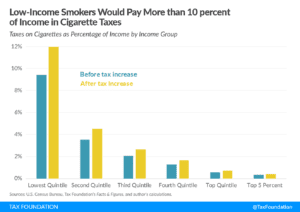
Higher taxes and graphic warnings are not the best ways to encourage smokers to switch to ENDS.
By George Gay
Towards the end of August, the U.S. Food and Drug Administration announced that it had issued marketing denial orders (MDOs) in respect of about 55,000 flavored electronic nicotine-delivery system (ENDS) products. At about the same time, the FDA announced also that the deadline for combustible-cigarette manufacturers to print new health warnings on their products and product advertising had been delayed until October 11, 2022.
I think these two developments will strike you as odd if you subscribe to two almost universally-held ideas: that the consumption of combustible cigarettes kills and that graphic health warnings help to discourage people from such consumption; and if you subscribe to the idea that is less widely held: that ENDS are the most effective products for helping people quit smoking.
Indeed, to say that these two developments seem odd is something of an understatement. They represent a world turned upside down; a world in which the consumption of combustible cigarettes, which are regarded as deadly, is not discouraged, while the consumption of less-risky, cigarette-substitute products is discouraged.

It is important to say, however, that what has happened is not entirely down to the FDA, which, in line with its obligations under the Tobacco Control Act of 2009, initially tried to bring in graphic health warnings on combustible cigarettes about 10 years ago, only to have them challenged in the courts and declared unconstitutional. The latest attempt at bringing in such warnings, the details of which became known in 2020, was similarly subjected to challenges, and to court-imposed delays.
However, it is reasonable, I think, to quarrel with the types of warnings proposed, which seem in large part to follow the same tired pattern of those used in other countries and regions. For instance, the proposed U.S. graphic warning pictures and captions, in line with those introduced elsewhere, do not tell the full story – that is, they don’t tell the whole truth.
Just to take one example; the caption on one picture reads, Warning: Smoking causes cataracts, which can lead to blindness. I don’t smoke, but I have cataracts forming; so obviously there are other causes of cataracts, the biggest of which I would say is probably, as in my case, getting old.
If there is to be an honest attempt at informing smokers, the cataracts warning needs to answer a lot of questions specifically aimed at people living in the U.S., questions that could be answered easily on a pack insert. Are there other causes of cataracts and what are they? At what age do smokers and non-smokers generally start to suffer from cataracts? Are cataracts more common in smokers than in non-smokers? Given that removing cataracts is one of the more common and more successful operations performed, how often do cataracts lead to blindness? Is the incidence of cataract-induced blindness more common among smokers than in the general population?
That the caption doesn’t answer these questions and the others that might rightly be raised by smokers, in my view is down to the paternalistic attitude of the FDA – and agencies in other countries that are in charge of determining the form of such warnings. Largely, I think, because smokers tend to be found in what are termed lower socio-economic groups, it is assumed they have to be told what is good for them without bothering their heads with details; whereas, in fact, some of them are rather smart.
Meanwhile, the FDA, while not being directly responsible for the delay in requiring health warnings on cigarette packs and advertising, is, in my view, more culpable in respect of the muddle over ENDS products. Basically, it has become hoist on its own petard – entrapped by its own propaganda about youth vaping.
In issuing its MDOs in August, the FDA said it had determined that the “applications for about 55,000 flavored ENDS products from three applicants lacked sufficient evidence that they have a benefit to adult smokers sufficient to overcome the public health threat posed by the well-documented, alarming levels of youth use of such products. The products from JD Nova Group LLC, Great American Vapes, and Vapor Salon subject to this action are non-tobacco-flavored ENDS and they include flavors such as Apple Crumble, Dr. Cola and Cinnamon Toast Cereal.”
This whole idea of considering public health, or population-wide health, rather than individual health, has its merits, but it is also flawed; as is the idea of utilitarianism on which it seems to be loosely based. If the idea is to bring about the maximum good for the maximum number of people, the calculations necessary become overwhelming and, in part, require the foretelling of the future.
As the FDA says, the applicant must demonstrate that the product is appropriate for the protection of public health. “This public or population health standard is quite high and requires considering the product’s risks and benefits to the population as a whole, including users and nonusers of the tobacco product, and taking into account the increased or decreased likelihood that existing users of tobacco products will stop using such products, and the increased or decreased likelihood that those who do not use tobacco products will start using such products,” it says.
If a doctor you have consulted wants to prescribe for you an inhaler, is it incumbent upon her to take into account the fact that the production of that inhaler, and all the inhalers you will need for the rest of your life, will produce CO2 emissions that will exacerbate the existential climate crisis we have created and, therefore, the health of Joe Blow, who will then need an inhaler so that there are now two such devices being produced on a regular basis along with more CO2…?
To my way of thinking, it makes sense to consider population-wide health effects where there is a population-wide health threat, such as that caused by pollution, which is a far bigger killer than is tobacco smoking but which is largely consigned by those who should be tackling it to the too-hard drawer. But it seems to make little sense where what is in question comprises health threats to individuals and possible solutions for those threats.
Of course, what those who like to consider population-wide health benefits or threats will tell you is that there is no point in allowing the sale of vaping devices so that middle-aged Joe Blow can use such devices to quit smoking if young man John Doe takes up vaping and goes on to become a smoker, at least when this example is extrapolated across the population. I really don’t accept this argument because, to me, Joe and John are individuals, as are all the other people who make up the population and who make their own choices about what they do with their lives.
What has happened here is that, as mentioned above, the FDA has found itself hemmed in by its own propaganda. Take another look at that part of the FDA’s statement above where it tries to justify dumping 55,000 vaping products and where it talks of: ‘the public health threat posed by the well-documented, alarming levels of youth use of such products’.
To me, the use of the word “alarming” is an example of where the FDA’s claim to scientific rigor runs out of road. Compare what the FDA had to say with what was stated recently in a report entitled, Balancing Consideration of the Risks and Benefits of E-Cigarettes, which, I understand, was penned by 15 past presidents of the Society for Research on Nicotine and Tobacco.
Although the authors argue that the overwhelming focus of US policies and media attention on decreasing youth vaping has distracted from the goal of reducing smoking, they concede that: “Still, concerns emanating from substantial increases in youth vaping in 2018 and 2019 are readily understandable and important to address.”
It is also important to take note of something else that I think is significant. A contributor to the Global Forum on Nicotine held in the UK earlier this year explained how U.S. government policies were driven by the fears and wishes of the majority population, made up of the suburban, white, middle-classes. This was why tobacco smoking, a habit mainly of the financially less-well-off, had been largely tolerated [health warnings delayed again], while vaping, the subject of scare stories about an epidemic among the children of the middle class, had launched a moral panic [55,000 products dumped].
The Balancing Consideration report is indeed a model of balance; as can be glimpsed from this passage: ‘Smokers unable to quit smoking with evidence-based cessation methods should be well informed about the relative risks of vaping and smoking and vaping’s potential to help them quit smoking. They should understand that, while the long-term health consequences are unknown, completely substituting vaping for smoking likely reduces health risks, possibly substantially.
Dual use of cigarettes and e-cigarettes will not have a comparable beneficial effect. However, a period of dual use may be necessary for some smokers to transition from smoking. Because vaping itself poses some risk, the best advice is to eventually stop vaping as well.’
I find it impossible to argue with almost anything in this passage or in the objective of the authors, which is to encourage more balanced consideration of vaping within public health and in the media and policy circles. There is certainly a need for such balance. As the authors say in the introduction to the report: “Opponents focus on e-cigarettes’ risks for young people, while supporters emphasize the potential for e-cigarettes to assist smokers in quitting smoking.
Most U.S. health organizations, media coverage, and policymakers have focused primarily on risks to youths. Because of their messaging, much of the public – including most smokers – now consider e-cigarette use as dangerous as or more dangerous than smoking.”
The authors are correct; this is a situation that needs to be rectified.
And yet, I cannot go along with everything in the report, though it talks with empathy about smokers. “Today’s smokers come disproportionately from lower education and income groups, the LGBTQ (lesbian, gay, bisexual, transgender, and queer or questioning) community, and populations suffering from mental health conditions and from other drug addictions,’ it says. ‘Smoking accounts for a significant proportion of the large life expectancy difference between affluent and poorer Americans.”
And the report is right in making the point that a lot of people hardly realise that smokers still exist. “To the more privileged members of society, today’s smokers may be nearly invisible,” it says. “Indeed, many affluent, educated US persons may believe the problem of smoking has been largely ‘solved.” They do not smoke. Their friends and colleagues do not smoke. There is no smoking in their workplaces, nor in the restaurants and bars they frequent. Yet one of every seven U.S. adults remains a smoker today.”
But then, to my mind, the report loses its way. “Tax cigarettes and other combustible tobacco products heavily; impose a more modest tax on e-cigarettes,” it advises. “Taxes should be proportionate to risk. A much higher tax on combustibles will encourage adult smokers to quit smoking or to switch to less expensive e-cigarettes. By raising the price of e-cigarettes, a modest tax will discourage their use by price-sensitive youths.”
There are several problems with this, I would suggest, partly perhaps because, I suspect, the authors don’t smoke and don’t generally rub shoulders with those in the lower socio-economic groups. The authors want to tax smokers heavily having already declared that these people generally come from groups less well-off financially. They say that this is to encourage smokers to stop smoking, but it is nothing of the sort. It is an attempt at bludgeoning them into giving up.
To my way of thinking, if a smoker is given the facts about her habit, partly through the medium of comprehensive, fact-based health warnings, and she chooses to keep smoking, that is her business. Hitting her with levels of taxes that would not be tolerated but for the fact that smokers comprise an unrepresented minority is grossly unfair.
And what will happen to the money raised? Will it be spent on helping these people? The record shows that this will not be the case. The money will be spent on politicians’ vanity projects, while nine million children will still go hungry.
And finally, what about the seemingly worthwhile aim of increasing the life expectancy of these smokers by bludgeoning them into quitting? Given that the last years of these people’s lives are hardly likely to be halcyon; it might be a good idea to ask them if they really want another 10 years of struggling to make ends meet as they become increasingly infirm. Walk – or perhaps hobble – a mile in my shoes.

























